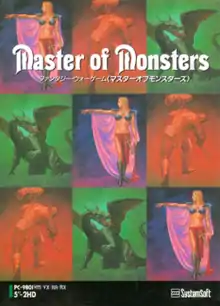Master of Monsters
Master of Monsters is a turn-based strategy game developed by SystemSoft for the MSX and NEC PC8801. It was later ported to a variety of consoles and PCs including the PC Engine, NEC PC9801, Sega Mega Drive (Genesis), Sega Saturn and PlayStation. While it never garnered the same success as its SystemSoft stablemate Daisenryaku, the game garnered a loyal following. Its success in the North American market on the Sega Genesis proved sufficient for a sequel on the Sega Saturn, and an anime art-style enhanced PlayStation version titled Disciples of Gaia with a Japanese role-playing game feel.
| Master of Monsters | |
|---|---|
 PC-9801 cover art | |
| Developer(s) | SystemSoft |
| Publisher(s) | SystemSoft |
| Composer(s) | Hayato Matsuo |
| Platform(s) | MSX, PC-8801, Sharp X1, PC Engine, PC-9801, Sega Genesis, Sega Saturn, PlayStation, Microsoft Windows |
| Release | |
| Genre(s) | Turn-based strategy game |
| Mode(s) | Single-player |
Gameplay
Gameplay engages players by permitting them to summon and move monsters around a board in an effort to capture towers and to eventually defeat the opponents (which are controlled either by other humans or by the computer program). Moves are based on a hexagonal board structure, such that every tile on the board is adjacent to six other tiles. Other notable features were the large variety of monsters, upgrading ("leveling up") of veteran units and control of a "Master" character who, if killed, can end the game for that player.
The focus of the game is strategic, despite the fantasy-type characters that might imply an RPG element. Other than the existence of the Master character and magic in the game, the gameplay is very similar to System Soft's more hardcore modern warfare strategic wargame series Daisenryaku, with the exception that some versions of the Master of Monsters (such as Master of Monsters – Final) series allow equippable items, weapons and armor.
Comparisons
The later Lords of Chaos by Julian Gollop of Mythos Games shares many of the same elements of summoning and tactics, along with the earlier title Chaos from 1985. David White, creator of the open-source turn-based strategy game Battle for Wesnoth, cited Master of Monsters as an inspiration.[1] Master of Monsters was also compared to later games such as the role-playing video game series Pokémon (which also revolves around commanding monsters) and the real-time strategy game Starcraft.[2]
Updates
System Soft Alpha returned the game to its strategy-based roots, and the two entries in the Master of Monsters series as originally popularized on the NEC 9801 PC were updated by System Soft Alpha with new graphics and gameplay features. Two more sequels were made for Japanese Windows and hark back to the deep strategic gameplay of the NEC PC9801 versions (as opposed to the more casual Genesis and PlayStation versions). Available for Japanese language Windows-based systems, the remakes include マスターオブモンスターズIII Special Edition, マスターオブモンスターズ4 ~光と闇の争覇~, Master of Monsters Value Edition (the original game, updated and with expansion packs added in), and 真・マスターオブモンスターズ Final. A spin-off of the game targeted towards the younger audience was titled Masumon Kids. A mobile version of the game is available in Japan.[3]
References
- "The History of, and Philosophy behind Wesnoth (2003 original)". Wesnoth.org. Retrieved 30 June 2019.
- Buchanan, Levi (17 June 2008). "Top 10 Renovation Games". IGN. Retrieved 12 August 2016.
- webmaster. "Vi". Retrieved 16 January 2015.